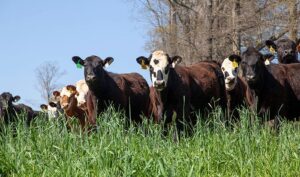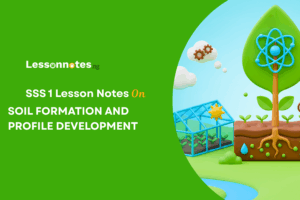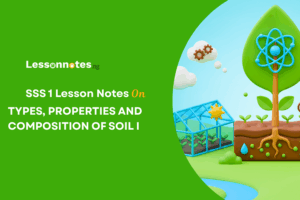Pasture, Forage Crops And Range Management SS2 Agricultural Science Lesson Note
Download Lesson NoteTopic: Pasture, Forage Crops And Range Management

Pasture: This is a piece of land on which forage crops grow.
Forage Crops: These are plants cultivated (or growing naturally) whose vegetative parts (leaves and stem) are fed on by livestock.
Uses Of Forage Crops
- They are used as livestock feeds
- They are used as cover crops which conserve soil moisture.
- They help in discouraging weed growth
- Some are leguminous which enrich soil nutrients.
- For prevention of erosion
- Used as green manure
- Used for roofing farmsteads
- As bedding materials
TYPES OF PASTURES
- Natural Pasture: also called natural grassland or rangeland is a piece of land on which grasses and legumes grow naturally on their own and are fed upon by farm animals
Characteristics Or Features Of Natural Pasture
i. It contains poor-quality grasses and legumes.
ii. It contains soil types that are low in fertility or nutrients.
iii. It contains wide varieties of grasses and legumes, some of which may not be eaten by livestock.
iv. It has good regenerative ability.
v. Crops here can withstand trampling.
- Artificial Pastures: this is also referred to as established or sown pasture is a piece of land that is where grasses and legumes are cultivated and managed by man to be fed by livestock.
Characteristics Features Of Artificial Pastures
i. It contains high-quality grass and legumes
ii. It contains no weed.
iii. Selected grasses and legumes are grown in adequate proportion
iv. Have high regenerative ability
v. Can withstand trampling by farm animals.
QUALITY OF A GOOD PASTURE PLANT
- Ability to regenerate fast after being browsed
- Ability to withstand trampling
- It must be highly palatable
- It must possess high value of nutrients
- Ability to withstand extreme climatic conditions
- It should have moderate moisture content or succulent
- It must have a high leaf-to-stem ratio
Grasses
| SN | COMMON NAME | BOTANICAL NAME |
| i | Elephant grass | Pennisetum purpureum |
| ii | Guinea grass | Panicum maximum |
| iii | Giant star grass | Cynodon plectostachyus |
| iv | Carpet grass | Axonopus compressus |
| v | Speargrass | Imperata cylindrical |
| vi | Bahama grass | Cynodon dactylon |
| vii | Northern gamba | Andropogon gayanus |
| viii | Southern gamba | Andropogon tectorum |
Legumes
| SN | COMMON NAME | BOTANICAL NAME |
| 1 | Centro | Centrosema pubescent |
| 2 | Stylo | Stylosanthes gracilis |
| 3 | Kudzu or Puerto | Pueraria |
| 4 | Calapo | Calopogonium mucunoides |
| 5 | Mucuna | Mucuna utilise |
| 6 | Sun hemp | Crotalaria juncea |
FACTORS AFFECTING THE DISTRIBUTION OF PASTURE
- Climatic factors
- Soil or edaphic factors
- Biotic factors
- Climatic Factors
The type of climate in an area influences the type of vegetation in the particular area e.g. Sudan’s type of climate favours the growth of grass and legume while the equatorial climate does not. The elements of climate which affect the distribution of pastures are rainfall, wind, temperature, relative humidity etc.
- Edaphic Factors
This refers to the level of fertility of the soil. Fertile soil enhances pasture growth and vice versa. Edaphic factors include soil PH, soil texture, soil structure, soil topography etc.
- Biotic Factors
Biotic factors like diseases, pests, parasites, and predators generally influence the distribution of pasture. Also human and animal activities such as bush burning and overgrazing will affect the distribution of pastures.
FACTOR AFFECTING THE PRODUCTIVITY OF PASTURES
- Persistence: ability to survive and spread by vegetative means.
- Aggressiveness: ability to compete favourably with other weeds.
- Resistance to trampling.
- Seed viability or profuseness or ease of propagation.
- Resistance to drought.
- Absence of pests and diseases.
- Good management.
- Adequate stocking.
ESTABLISHMENT OF PASTURES
Before pasture can be established, the following factors should be considered:
- Adaptation of species
- Palatability
- Compatibility
- Time of maturity: Should be short
- Lifestyle of the species
STEPS IN ESTABLISHING A PASTURE
- Site selection.
- Clearing of land.
- Removal of debris
- Cultivation of site (land preparation).
- Planting of pasture crops.
- Supplying.
- Promotion of tillers (more points of growth).
- Weeding.
- Fertilizer application.
- Irrigation.
- Paddocking.
MANAGEMENT PRACTICES IN PASTURE
- Burning (when forage becomes fibrous to ensure regrowth of lush forage)
- Fencing to discourage overgrazing or facilitate rotational grazing.
- Fertilizer application or manuring.
- Regular weed control.
- Adequate pest and disease control.
- Irrigation.
- Adequate stocking.
ASSIGNMENT
- Which of the following is not a climatic factor affecting pasture distribution? A. Temperature B. Light C. Humidity D. Soil PH
- The following are edaphic factors except A. soil PH B. soil texture C. soil structure D. relative humidity
- Diseases, pests, predators and parasites are ____ factors. A. biotic B. abiotic C. edaphic
- climatic
- The act of re-planting pastures that fail to germinate is ______. A. thinning B. supplying C. weeding D. mulching
- The following are legumes except _____. A. centro B. stylo C. calapo D. gamba





















